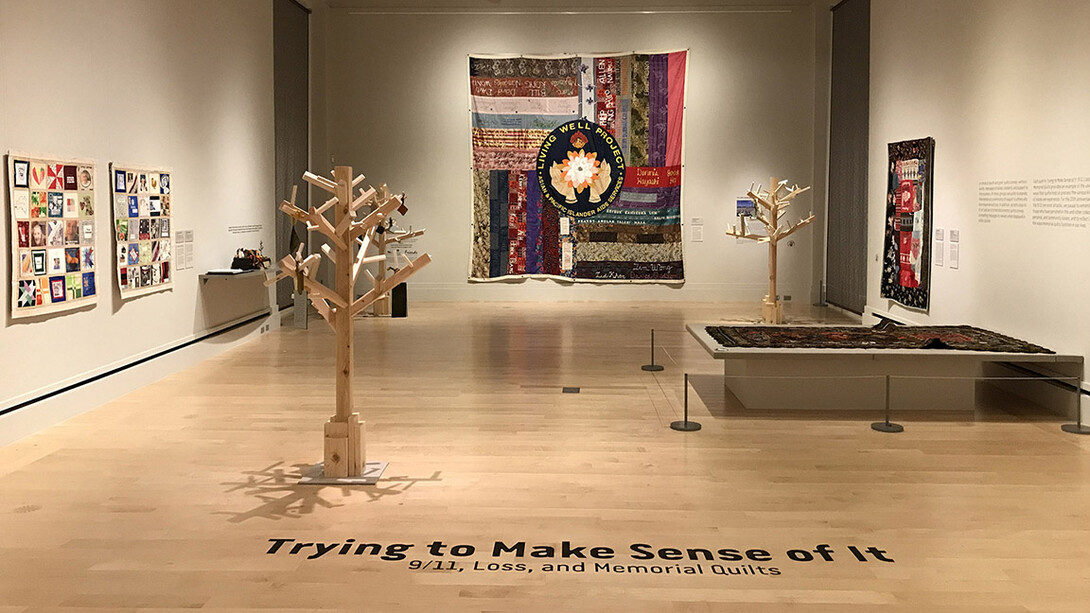
The International Quilt Museum is presenting quilts in a physical and digital installation that commemorate the individuals who lost their lives in the 9/11 attacks. The exhibition also addresses the recent loss of life due to the COVID-19 pandemic and racial violence.
This September marks the 20th anniversary of the 9/11 terrorist attacks. To commemorate the 2,977 people who died at the World Trade Center, the Pentagon and in Shanksville, Pennsylvania, the International Quilt Museum created “Trying to Make Sense of It: 9/11, Loss, and Memorial Quilts.” On view through Oct. 16, the exhibition explores both the collective losses of 9/11 and the poignancy of each individual loss.
The exhibition builds upon the powerful impact of the AIDS Memorial Quilt to demonstrate the unique ways that quilts can honor individual lives and call attention to events of global significance.
“For the 20th anniversary of the 9/11 terrorist attacks, it is important to remember those who have perished in this and other collective, personal and community losses, and to reflect upon the ways memorial quilts function in our lives,” said Leslie Levy, the Ardis and Robert James Executive Director of the museum.
The exhibition includes nine panels from the “United in Memory 9/11 Victims Memorial Quilt.” The quilt consists of more than 140 individual quilts or panels, which include 25 blocks each. Each block is dedicated to one of the 2,977 victims of the attacks. Because of its large size, only a selection of panels are shown at any given time.
The entire 9/11 quilt is on view through an interactive kiosk in the gallery. Visitors may browse the quilt or search for a name to see the block dedicated to that individual.
“The United in Memorial 9/11 Victims Memorial Quilt is an iconic reminder of a pivotal event in American history, and it is important we share it with each new generation,” Levy said.
Roughly 80 million Americans are were born before the events of 9/11. The exhibition provides an educational experience for youth and an opportunity for reflection for everyone, Levy said.
An AIDS Memorial Quilt block anchors one of three galleries in “Trying to Make Sense of It.” The AIDS quilt is the largest folk art object in the world and has inspired countless other public memorial quilts since its founding.
Panels of the COVID Memorial Quilt, founded by 13-year-old Madeleine Fugate, are also on display. Patterned after the AIDS Memorial Quilt, the grassroots project seeks to put names to the individuals whom the virus has killed. Fugate began in March 2020, when there were fewer than 4,000 deaths in the United States. To date, more than 620,000 have died in the United States, and 4.3 million globally.
A unique group of artist-made memorial quilts, meanwhile, call attention to deaths due to racial and ethnic violence in 2020 and before.
“As we planned to commemorate the 20th anniversary of the 9/11 attacks, we reflected on recent losses fresh in our memories,” said Jonathan Gregory, the museum’s curator of the new exhibition. “We decided to include memorial quilts focused on losses due to the COVID-19 pandemic, racial violence in American cities, missing and murdered Indigenous people, and the global refugee crisis. These quilts are both beautiful and deeply affecting.”
The museum will hold a number of public programs in conjunction with the exhibition, including a curator-led tour of the exhibition on Sept. 11; and an opportunity for visitors to share their memorial quilts on Sept. 18. Information about the exhibition and programs is available from the museum.







